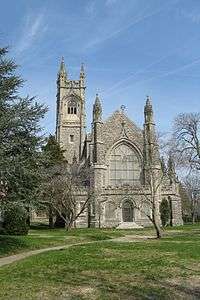Unitarian Memorial Church
|
Unitarian Memorial Church | |
|
Unitarian Memorial Church | |
  | |
| Location | Fairhaven, Massachusetts |
|---|---|
| Coordinates | 41°38′1″N 70°54′9″W / 41.63361°N 70.90250°WCoordinates: 41°38′1″N 70°54′9″W / 41.63361°N 70.90250°W |
| Built | 1901 |
| Architect | Charles Brigham |
| Architectural style | Late Gothic Revival |
| NRHP Reference # | [1] |
| Added to NRHP | November 22, 1996 |
Unitarian Memorial Church is a historic church on 102 Green Street in Fairhaven, Massachusetts.
The church was added to the National Register of Historic Places in 1996.
The Unitarian Memorial Church in Fairhaven Massachusetts was built, financed and donated to the Unitarians in 1904 by Henry H. Rogers in memory of his mother, Mary Eldredge Huttleston. The church was designed by Boston architect Charles Brigham in a Gothic Revival style.[2] It is one hundred fourteen feet in height, one hundred feet long in body and fifty-three feet wide. The nave is thirty-two feet wide and seventy-one feet long. The main aisle is sixty-two feet long and six feet wide. The church, parish house and former parsonage (now Harrop Center) of the Unitarian Society are so placed as to form three sides of a quadrangle, set among well-kept lawns and shrubbery. Granite (locally quarried) with Indiana limestone decorative carvings dominate the exterior while marble and limestone carvings dominate the interior. All stonework artistry was created by forty-five Italian craftsmen brought to Fairhaven by Rogers.
Sanctuary
All the woodwork in the sanctuary is English bog oak carved by forty-five Bavarian craftsmen. No two carvings are alike on the thirty-two pews, the ornate pulpit, the organ pipe cases, the choir screen or the doors. In the rafters above the pews are ten wooden angels covered in beaten gold. Each ten foot high angel holds articles and bear inscriptions symbolizing ten attributes of the intellectual life. The south entrance has twelve bronze symbols of the zodiac inlaid in the marble floor.
Tower
The great tower, over one hundred and sixty-five feet high, of sparkling granite and carved limestone, is a landmark for many miles. There are one hundred eighty granite steps leading to the tower. In this tower is a finely adjusted D Chime of eleven bells. They weigh a total of 14,000 pounds and are played (struck) by iron hammers. The bells were cast by Chester Meneelly of the Meneelly Bell Company of Troy, New York. The original ringer’s gallery is still in the tower even though the bells are now played both by hand or electronically from a small room in the sanctuary.
Bronze doors
At the south entrance to the sanctuary are the great bronze doors, extremely rich in design, each leaf is solid bronze weighing 2 1/4 tons. Following the Gothic outline of each leaf is a series of niches. Those on the exterior are canopied, each containing a finely modeled figure nine inches high. The thirty-eight statues represent great characters in the history of Christianity, covering a period of nineteen centuries.
Baptismal font
From the cloister with its ornate bronze gates and marble mosaic floor we enter the foyer with the baptismal font. The font sits on elegant white Indian marble inlaid with bronze lettering. Over the font hangs a large oak canopy carved by Johannes Kirchmayer with ten angels each holding a scroll engraved with one of the Ten Commandments. Above them are ten standing figures of men who preached and spread Christianity throughout the world. Below the majestic vaulted ceiling in four corners are stone carvings symbolizing the four stages of womanhood: Infant, Youth, Maturity and Old Age. The beautiful bronze medallions inlaid in the marble floor represent Matthew, Mark, Luke and John.
Organ
The organ manufactured by the Hutchings and Votey Company was installed in 1909. With 2,300 pipes (24 ranks) on 3 manuals, it was considered one of the finest in the country at that time. When the new hot-air heating system installed in 1968 ruined the Hutchings pneumatic mechanism, the organ was replaced by Roche Organ Co of Taunton MA in 1971 saving exterior casework and 12 original ranks increasing the number of ranks to 60, 3450 pipes. The console was relocated from the left side to the center of the organ loft at that time. A digital upgrade of the console was accomplished by Barry Turley in 2008. Today, the Organ remains among the finest for its size. All the ornamental pipes on the organ case are covered in beaten gold, the color of clouded silver. They are decorated very ornately.
Stained glass windows
The stained glass windows are the work of American Impressionist artist, Robert Reid. They cover the theme of the birth of Jesus in the Memorial Window utilizing color and shading from cool blues to warm earth tones through the nine clerestory windows from East to West. Seven of these windows are titled with one of the Beatitudes (or Blessed Be’s) which Jesus was teaching his Disciples as illuminated in the glorious twenty-four foot high Sermon on the Mount window located on the west wall. One notable effect of the windows is the natural flesh quality in the figures. Two years were spent in their design and execution. These stained glass windows were Reid’s most prized work, a masterpiece set and his only effort in stained glass.
See also
References
- ↑ National Park Service (2008-04-15). "National Register Information System". National Register of Historic Places. National Park Service.
- ↑ "MACRIS inventory record for Unitarian Memorial Church". Commonwealth of Massachusetts. Retrieved 2014-06-14.
| Wikimedia Commons has media related to Unitarian Memorial Church. |

